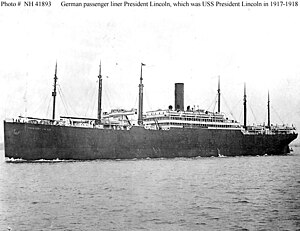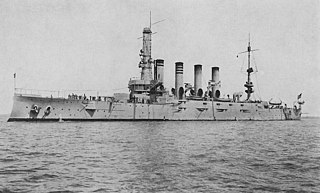
The first USS West Virginia (ACR-5/CA-5), also referred to as "Armored Cruiser No. 5", and later renamed Huntington, was a United States Navy Pennsylvania-class armored cruiser.

USS Little (DD-79/APD-4), a Wickes-class destroyer in the United States Navy during World War I and World War II. She was the first Navy ship named for George Little (1754–1809).

USS Mercy (ID-1305/AH-4) was a hospital ship in the United States Navy during World War I. She was the first U.S. Navy ship of that name. The ship was previously known as SS Saratoga, a steamer for the Ward Line on the New York to Havana route, and considered the fastest steamship in coastal trade. Before being purchased by the Navy, the ship was briefly employed as United States Army transport ship USAT Saratoga, a career that ended after a collision off Staten Island, New York.

USS Smith (DD–17) was the lead ship of Smith-class destroyers in the United States Navy. She was the first ship named for Lieutenant Joseph B. Smith. Entering service in 1909, the destroyer was placed in reserve in 1912. She was reactivated for World War I and, following the war, was used as a test ship for aerial bombing. In 1921, the vessel was sold for scrapping.

USS Susquehanna (ID-3016) was a transport for the United States Navy during World War I. She was the second U.S. Navy ship to be named for the Susquehanna River. Before the war she operated at SS Rhein, an ocean liner for North German Lloyd. She was the lead ship of her class of three ocean liners. After the end of World War I, the ship operated briefly in passenger service as SS Susquehanna. Laid up in 1922, Susquehanna was sold to Japanese ship breakers in 1928 and scrapped.
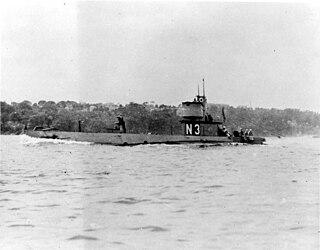
USS N-3 (SS-55) was a N-class coastal defense submarine in commission in the United States Navy from 1917 to 1926. She saw service during World War I.

The first USS Amphion was a former German passenger liner SS Köln for Norddeutscher Lloyd from 1899–1917. Köln had been interned in Boston on the outbreak of war in Europe and confiscated in April 1917 when the United States entered the war. The ship was under the control of the United States Shipping Board (USSB) that allocated commercial type ships to military or civilian use during the war. Köln was renamed Amphion and operated by USSB for the Army as United States Army Chartered Transport (U.S.A.C.T.) Amphion as an animal transport taking mules, horses and general cargo to forces in Europe. At the end of the war the USSB allocated the ship to the Navy, which used the ship from April to September 1919 as a troop transport for returning the United States Expeditionary Force from Europe.

USS Sampson (DD-63) was the lead ship of her class of destroyers of the United States Navy. She was the first Navy ship named for Admiral William T. Sampson (1840–1902).

USS Comfort (AH-3) was a hospital ship for the United States Navy in World War I. She was the sister ship of USS Mercy (AH-4) but the two ships were not of a ship class. Comfort was known as SS Havana in passenger service for the Ward Line, and as USAT Havana in United States Army service before her Navy service. Her name was restored to Havana in 1927, and she was renamed SS Yucatán in 1935, and SS Agwileon in 1941. In World War II, she was known as USAT Agwileon and USAHS Shamrock in service for the United States Army.

The first USS Henderson (AP-1) was a transport in the United States Navy during World War I and World War II. In 1943, she was converted to a hospital ship and commissioned as USS Bountiful (AH-9).
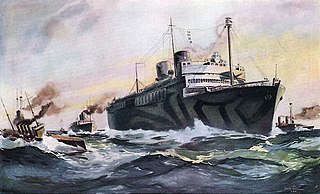
USS Siboney (ID-2999) was a United States Navy troopship in World War I. She was the sister ship of USS Orizaba (ID-1536). Launched as SS Oriente, she was soon renamed after Siboney, Cuba, a landing site of United States forces during the Spanish–American War. After her navy service ended, she was SS Siboney for the New York & Cuba Mail Steamship Co.. The ship was operated under charter by American Export Lines beginning in late 1940. During World War II she served the U.S. Army as transport USAT Siboney and as hospital ship USAHS Charles A. Stafford.

USS Aeolus (ID-3005), sometimes also spelled Æolus, was a United States Navy transport ship during World War I. She was formerly the North German Lloyd liner SS Grosser Kurfürst, also spelled Großer Kurfürst, launched in 1899 that sailed regularly between Bremen and New York. At the outset of World War I the ship was interned by the United States and, when the U.S. entered the conflict in 1917, was seized and converted to a troop transport.
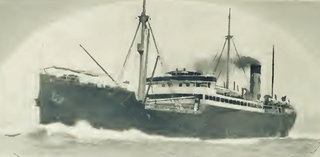
USS Wilhelmina (ID-2168) was a transport for the United States Navy during World War I. Built in 1909 for Matson Navigation Company as SS Wilhelmina, she sailed from the West Coast of the United States to Hawaii until 1917. After her war service, she was returned to Matson and resumed Pacific Ocean service. In the late 1930s she was laid up in San Francisco, California, until sold to a British shipping company in 1940. While a part of a convoy sailing from Halifax, Nova Scotia, to Liverpool, she was sunk by U-94 on 2 December 1940.

USS Lenape (ID-2700) was a troop transport for the United States Navy in 1918, during World War I. She was launched in 1912 as SS Lenape, a passenger steamer for the Clyde Line. After the entry of the United States into World War I in 1917, she was chartered by the United States Army as transport USAT Lenape. After her Navy service ended in October 1918, she was returned to the Army.
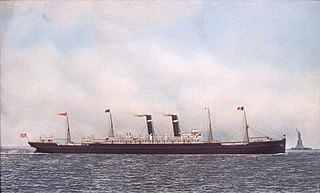
SS Finland was an American-flagged ocean liner built in 1902 for the Red Star Line. During World War I she served as a transport for the United States Navy named USS Finland (ID-4543). Before her Navy service in 1917, she was also USAT Finland for the United States Army.

USS Rijndam (ID–2505) was the Holland America Line (HAL) ocean liner Rijndam, also spelt Ryndam, which was launched in Ireland in 1901 and scrapped in the Netherlands in 1929. The US requisitioned her as the United States Navy troopship USS Rijndam from 1918 until 1919. She was the first of four Holland America Line ships to be called Ryndam.
SS Duca d'Aosta was an Italian ocean liner for Navigazione Generale Italiana named after one of the Dukes of Aosta. Launched in 1908, she sailed between Italy and New York and South America for most of her career. During World War I she was employed as a troopship carrying United States troops to France as part of the United States Navy Cruiser and Transport Force. She was scrapped in 1929.

USS Tenadores was a transport ship for the United States Navy during World War I. Before the war she was known as SS Tenadores in the service of the United Fruit Company. Before her Navy service, she served as a United States Army transport under the name USAT Tenadores.
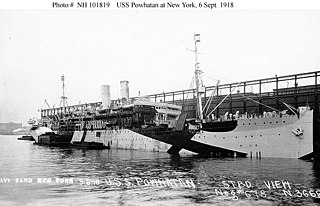
USS Powhatan (ID–3013) was a transport ship for the United States Navy during World War I. She was originally the SS Hamburg, a Barbarossa-class ocean liner built in 1899 by Aktiengesellschaft Vulkan of Stettin, Germany, for the Hamburg America Line. At the outset of World War I the ship was interned by the United States.
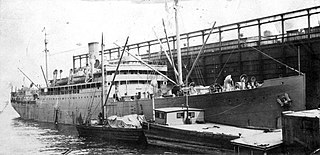
USS Henry R. Mallory (ID-1280) was a transport for the United States Navy during World War I. She was also sometimes referred to as USS H. R. Mallory or as USS Mallory. Before her Navy service she was USAT Henry R. Mallory as a United States Army transport ship. From her 1916 launch, and after her World War I military service, she was known as SS Henry R. Mallory for the Mallory Lines. Pressed into service as a troopship in World War II by the War Shipping Administration, she was torpedoed by the German submarine U-402 in the North Atlantic Ocean and sank with the loss of 272 men—over half of those on board.
